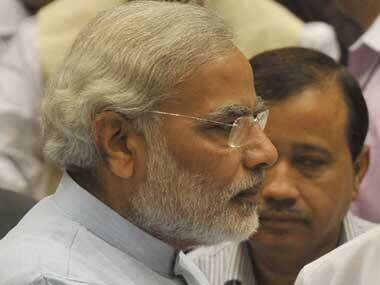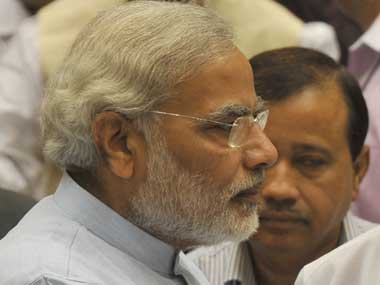A series of oblique messages sent out by Bihar Chief Minister Nitish Kumar on his Gujarati counterpart Narendra Modi’s secularism has, for the umpteenth time, thrown open a discussion on the question of ‘acceptability’ as the key consideration in determining the BJP’s prime ministerial candidate in the next Lok Sabha elections. As soon as Sanjay Joshi’s resignation from the BJP national executive led to Modi being anointed as the proverbial first among equals, various op-eds elaborately explored Modi’s ‘unacceptability’ as a principal reason why his chances of becoming India’s prime minister are remote. Nitish Kumar has jumped on this bandwagon and, by incoherently juxtaposing secularism with sympathy for the poorer states, made his preferences—which, though cloaked with principles and morals, are aimed at excluding one person—loud and clear.[caption id=“attachment_353999” align=“alignleft” width=“380” caption=“Aiming high. PTI”]
 [/caption] While now is too soon for the BJP to decide its prime ministerial candidate, Nitish’s statements should make the party think carefully of how it goes about its preparation for the Lok Sabha polls. If it chooses Modi as one of the principal players to significantly accentuate BJP’s nationwide appeal after the Gujarat assembly elections later this year, the decision cannot be taken without certitude and boldness. The BJP must, to begin with, ensure that the recent clamour for an ‘acceptable’ face is not shorthand for a malleable candidate who can be arm-twisted into silence and inaction like what has happened to Prime Minister Manmohan Singh in UPA-2. Back in 2004, anointing Singh as India’s Prime Minister was considered a ‘master-stroke’ by Sonia Gandhi. Singh, however, was a creation of differing factors at play. A few allies as well as a BJP staunchly opposing the idea of a foreign-born PM led Sonia Gandhi making a grand sacrifice. The overall malleability of Singh—as opposed to the rather intractable Pranab Mukherjee—resulted in Singh’s prime ministership. Singh resembled, in mathematical terms, the Highest Common Factor (or, the Greatest Common Divisor) which was created to blend with these differing factors at play. These factors were favorrable for the most part of UPA-1. And even when the Left threatened to withdraw its support during the Indo-US nuclear deal, the HCF stood his ground. The SP replaced the Left to give the UPA the necessary numbers. The second innings of the UPA government, however, has resulted in a dramatic and drastic reduction in the value of the HCF. Some numbers at play—the DMK first and the TMC recently—have spoilt the equation, thereby reducing the HCF to a sorry and helpless value. And, because of that, what 7, Race Course Road, exudes today is a near-complete paralysis in governance and an absolute lack of inspiration to propel India to her promised glory. Far from being a confident and assured march, the coalition-burdened Manmohan Singh government is submissively crawling its way into 2014. Sector 1 in Gandhinagar, on the other hand, is exhibiting waves of dynamism led by the individualistic and perceptibly authoritarian, but charismatic and workaholic, Narendra Modi. By putting an ideal mixture of solid visible performance and a craftily-designed public relations strategy highlighting that performance, Modi has announced his eligibility for the top job. While Singh is, indeed, the toast of global leaders at various ‘G summits’, and may also achieve the much needed path-breaking progress in our relations with Pakistan, a PM’s first mandate is to govern the nation. And he has been found seriously wanting. Modi is the most recognisable face to have filled this vacuum. He has consistently been vocal (and elaborate) about critical issues affecting the farthest corners of our country, often offering solutions—a far cry from the conspicuous silence of the PM as well as the chairperson of the Congress and her son—touted to be India’s next leader. And, despite ungracious barbs by rivals and hostile allies, Modi has maintained a dignified silence focusing solely on nurturing a creed of his own – that of sustainable vikaas_._ Modi is, knowingly or otherwise, carving his own tunnel to New Delhi, bringing with him a package which consists of his track record, his inspirational leadership among BJP cadres, his workaholic nature and his electoral importance. This package is what lends itself to the “idea of Modi”. The cult commanded by this idea—the mass following—has the potential, as Pratap Bhanu Mehta, who coined this phrase,
says
, of mobilising and inspiring the BJP to fully exploit its untapped potential. This idea of Modi more closely represents the mathematical natural number one which commands an existence of its own as opposed to an HCF created by various factors at play. While the HCF changes in value each time the numbers at play change, no number can either expand when multiplied, or reduce when divided, by one. Whether Modi occupies the highest executive pedestal in India depends first on the election outcome. And what role Modi plays in accentuating the BJP’s nationwide electoral chances depends on the party. Amid warnings and threats from allies, the irrefutable message for Nitin Gadkari is that the importance of the natural number one must outweigh the nebulous notion of ‘acceptability’. Because slowly, but surely, a country craving for strong, decisive and active leadership is bracing itself to the idea of the mathematical natural number one. And the BJP is best placed to give shape to this idea. Whether, and how, it takes the courageous leap of faith is the question.
[/caption] While now is too soon for the BJP to decide its prime ministerial candidate, Nitish’s statements should make the party think carefully of how it goes about its preparation for the Lok Sabha polls. If it chooses Modi as one of the principal players to significantly accentuate BJP’s nationwide appeal after the Gujarat assembly elections later this year, the decision cannot be taken without certitude and boldness. The BJP must, to begin with, ensure that the recent clamour for an ‘acceptable’ face is not shorthand for a malleable candidate who can be arm-twisted into silence and inaction like what has happened to Prime Minister Manmohan Singh in UPA-2. Back in 2004, anointing Singh as India’s Prime Minister was considered a ‘master-stroke’ by Sonia Gandhi. Singh, however, was a creation of differing factors at play. A few allies as well as a BJP staunchly opposing the idea of a foreign-born PM led Sonia Gandhi making a grand sacrifice. The overall malleability of Singh—as opposed to the rather intractable Pranab Mukherjee—resulted in Singh’s prime ministership. Singh resembled, in mathematical terms, the Highest Common Factor (or, the Greatest Common Divisor) which was created to blend with these differing factors at play. These factors were favorrable for the most part of UPA-1. And even when the Left threatened to withdraw its support during the Indo-US nuclear deal, the HCF stood his ground. The SP replaced the Left to give the UPA the necessary numbers. The second innings of the UPA government, however, has resulted in a dramatic and drastic reduction in the value of the HCF. Some numbers at play—the DMK first and the TMC recently—have spoilt the equation, thereby reducing the HCF to a sorry and helpless value. And, because of that, what 7, Race Course Road, exudes today is a near-complete paralysis in governance and an absolute lack of inspiration to propel India to her promised glory. Far from being a confident and assured march, the coalition-burdened Manmohan Singh government is submissively crawling its way into 2014. Sector 1 in Gandhinagar, on the other hand, is exhibiting waves of dynamism led by the individualistic and perceptibly authoritarian, but charismatic and workaholic, Narendra Modi. By putting an ideal mixture of solid visible performance and a craftily-designed public relations strategy highlighting that performance, Modi has announced his eligibility for the top job. While Singh is, indeed, the toast of global leaders at various ‘G summits’, and may also achieve the much needed path-breaking progress in our relations with Pakistan, a PM’s first mandate is to govern the nation. And he has been found seriously wanting. Modi is the most recognisable face to have filled this vacuum. He has consistently been vocal (and elaborate) about critical issues affecting the farthest corners of our country, often offering solutions—a far cry from the conspicuous silence of the PM as well as the chairperson of the Congress and her son—touted to be India’s next leader. And, despite ungracious barbs by rivals and hostile allies, Modi has maintained a dignified silence focusing solely on nurturing a creed of his own – that of sustainable vikaas_._ Modi is, knowingly or otherwise, carving his own tunnel to New Delhi, bringing with him a package which consists of his track record, his inspirational leadership among BJP cadres, his workaholic nature and his electoral importance. This package is what lends itself to the “idea of Modi”. The cult commanded by this idea—the mass following—has the potential, as Pratap Bhanu Mehta, who coined this phrase,
says
, of mobilising and inspiring the BJP to fully exploit its untapped potential. This idea of Modi more closely represents the mathematical natural number one which commands an existence of its own as opposed to an HCF created by various factors at play. While the HCF changes in value each time the numbers at play change, no number can either expand when multiplied, or reduce when divided, by one. Whether Modi occupies the highest executive pedestal in India depends first on the election outcome. And what role Modi plays in accentuating the BJP’s nationwide electoral chances depends on the party. Amid warnings and threats from allies, the irrefutable message for Nitin Gadkari is that the importance of the natural number one must outweigh the nebulous notion of ‘acceptability’. Because slowly, but surely, a country craving for strong, decisive and active leadership is bracing itself to the idea of the mathematical natural number one. And the BJP is best placed to give shape to this idea. Whether, and how, it takes the courageous leap of faith is the question.
The ‘idea of Modi’ is more critical than his acceptability
Kartikeya
• June 22, 2012, 15:10:51 IST
Is acceptability more important for a leader than his individuality and competence? This is the case for Modi.
Advertisement
)
End of Article